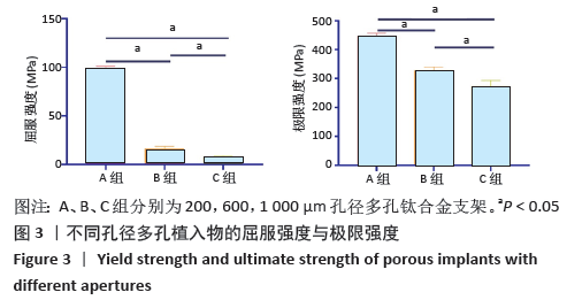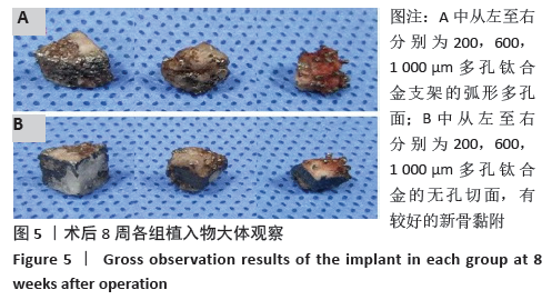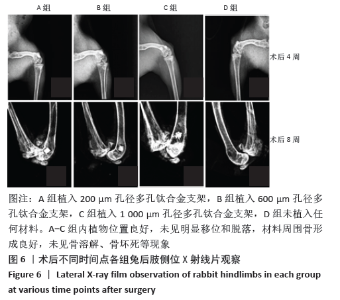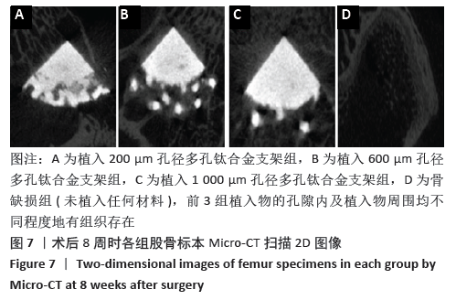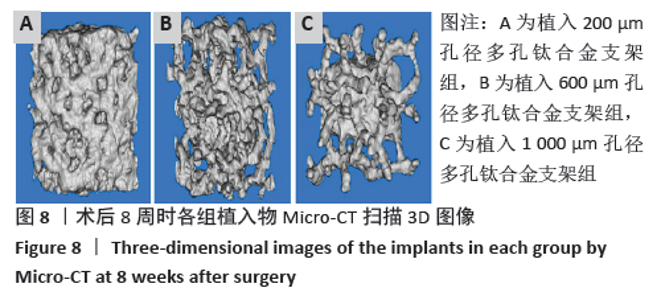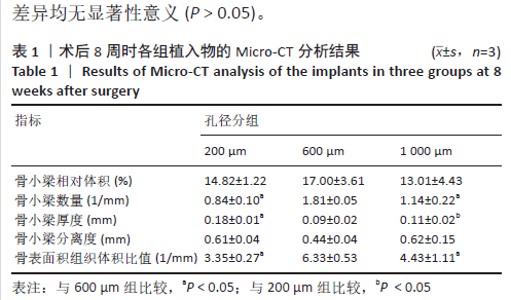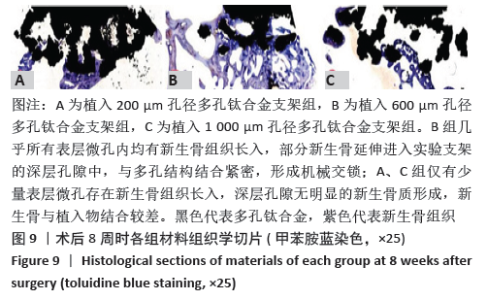[1] WANG L, QIU Y, LV H, et al. 3D Superelastic scaffolds constructed from flexible inorganic nanofibers with self-fitting capability and tailorable gradient for bone regeneration. Adv Mater. 2019;29(31):1901407.
[2] 王进,葛建飞,郭开今,等.3D打印多孔材料应用于骨缺损修复的研究进展[J].中华骨与关节外科杂志,2019,12(7):556-560.
[3] CUI L, ZHANG J, ZOU J, et al. Electroactive composite scaffold with locally expressed osteoinductive factor for synergistic bone repair upon electrical stimulation. Biomaterials. 2020;230:119617.
[4] OTTRIA L, LAURITANO D, BASSI MA, et al. Mechanical, chemical and biological aspects of titanium and titanium alloys in implant dentistry. J Biol Regul Homeost Agents. 2018;321(2):81-90.
[5] 吕嘉,刘忠军,冯毅,等.基于电子束熔融技术制备的多孔钛合金的细胞相容性[J].中华实验外科杂志,2018,35(6):1129-1132.
[6] GUILLEM-MARTI J, CINCA N, PUNSET M, et al. Porous titanium-hydroxyapatite composite coating obtained on titanium by cold gas spray with high bond strength for biomedical applications. Colloids Surf B Biointerfaces. 2019;180:245-253.
[7] OUYANG P, DONG H, HE X, et al. Hydromechanical mechanism behind the effect of pore size of porous titanium scaffolds on osteoblast response and bone ingrowth. Mater Design. 2019;183:108151.
[8] SUMNER DR. Long-term implant fixation and stress-shielding in total hip replacement. J Biomech. 2015;48(5):797-800.
[9] DUTTA B, FROES FHS. The additive manufacturing (AM) of titanium alloys. Titanium Powder Metall. 2015:447-468.
[10] YADROITSAVA I, DU PLESSIS A, YADROITSEV I. Bone regeneration on implants of titanium alloys produced by laser powder bed fusion: A review. Titanium for Consumer Applications. 2019:197-233.
[11] PAŁKA K, POKROWIECKI R. Porous Titanium implants: A review. Adv Eng Mater. 2018;20(5):1700648.
[12] YU T, GAO H, LIU T, et al. Effects of immediately static loading on osteointegration and osteogenesis around 3D-printed porous implant: A histological and biomechanical study. Mater Sci Eng C Mater Biol Appl. 2020;108:110406.
[13] MATENA J, PETERSEN S, GIESEKE M, et al. SLM produced porous titanium implant improvements for enhanced vascularization and osteoblast seeding. Int J Mol Sci. 2015;16(4):7478-7492.
[14] 李晓宇,宋超伟,费琦,等.骨修复3D打印钛合金支架材料的研究进展[J].临床和实验医学杂志,2019,18(2):114-117.
[15] LUAN H, WANG L, REN W, et al. The effect of pore size and porosity of Ti6Al4V scaffolds on MC3T3-E1 cells and tissue in rabbits. Sci China Technol Sci. 2019; 62(7):1160-1168.
[16] RAN Q, YANG W, HU Y, et al. Osteogenesis of 3D printed porous Ti6Al4V implants with different pore sizes. J Mech Behav Biomed Mater. 2018;84:1-11.
[17] 高志祥,龙能吉,张少云,等.髋关节翻修术应用3D打印植入物的研究进展[J].中华关节外科杂志(电子版),2019,13(6):731-735.
[18] KARAGEORGIOU V, KAPLAN D. Porosity of 3D biomaterial scaffolds and osteogenesis. Biomaterials. 2005;26(27):5474-5491.
[19] BAI F, WANG Z, LU J, et al. The correlation between the internal structure and vascularization of controllable porous bioceramic materials in vivo: A quantitative study. Tissue Eng Part A. 2010;16(12):3791-3803.
[20] MARIOTTO SFF, GUIDO V, YAO CHO L, et al. Porous stainless steel for biomedical applications. Mater Res. 2011;14(2): 146-154.
[21] 刘邦定,郭征,郝玉琳,等.多孔钛合金不同孔径大小对新骨长入的影响[J].现代生物医学进展,2012,12(9):1601-1604.
[22] CAI Q, YANG J, BEI J, et al. A novel porous cells scaffold made of polylactide–dextran blend by combining phase-separation and particle-leaching techniques. Biomaterials. 2002;23(23):4483-4492.
[23] YANG Y, ZHAO J, ZHAO Y, et al. Formation of porous PLGA scaffolds by a combining method of thermally induced phase separation and porogen leaching. J Appl Polym Sci. 2008;109(2):1232-1241.
[24] SALERNO A, OLIVIERO M, DI MAIO E, et al. Design of porous polymeric scaffolds by gas foaming of heterogeneous blends. J Mater Sci Mater Med. 2009;20(10): 2043-2051.
[25] PONADER S, VON WILMOWSKY C, WIDENMAYER M, et al. In vivo performance of selective electron beam-melted Ti-6Al-4V structures. J Biomed Mater Res A. 2010;92A(1):56-62.
[26] ZHAO L, WEI Y, LI J, et al. Initial osteoblast functions on Ti-5Zr-3Sn-5Mo-15Nb titanium alloy surfaces modified by microarc oxidation. J Biomed Mater Res A. 2010;92A(2):432-440.
[27] LI X, FENG Y, WANG C, et al. Evaluation of biological properties of electron beam melted Ti6al4v implant with biomimetic coating in vitro and in vivo. PLoS One. 2012;7:e5204912.
[28] ENTEZARI A, ROOHANI I, LI G, et al. Architectural design of 3d printed scaffolds controls the volume and functionality of newly formed bone. Adv Healthc Mater. 2019;8:18013531.
[29] ZHU T, CUI Y, ZHANG M, et al. Engineered three-dimensional scaffolds for enhanced bone regeneration in osteonecrosis. Bioact Mater. 2020;5(3):584-601.
[30] NUNE KC, LI S, MISRA RDK. Advancements in three-dimensional titanium alloy mesh scaffolds fabricated by electron beam melting for biomedical devices: mechanical and biological aspects. Sci China Mater. 2018;61(4SI):455-474.
[31] 徐秀林,薛文东,戴克戎.正常人皮质骨压缩力学性能实验研究[J].医用生物力学,1996(1):26-29.
[32] LEE B, LEE H, LEE K, et al. Enhanced osseointegration of Ti6Al4V ELI screws built-up by electron beam additive manufacturing: An experimental study in rabbits. Appl Surf Sci. 2020;508:145160.
[33] ]LI J, LI Z, LI R, et al. In vitro and in vivo evaluations of mechanical properties, biocompatibility and osteogenic ability of sintered porous titanium alloy implant. RSC Adv. 2018;8(64):36512-36520.
[34] 付君,倪明,陈继营,等.个性化3D打印多孔钛合金加强块重建重度髋臼骨缺损的生物相容性和生物力学研究[J].中国矫形外科杂志,2018,26(10): 945-950.
[35] CHEN Z, YAN X, YIN S, et al. Influence of the pore size and porosity of selective laser melted Ti6Al4V ELI porous scaffold on cell proliferation, osteogenesis and bone ingrowth. Mater Sci Eng C Mater Biol Appl. 2020;106:110289.
[36] 黎立,赵伊婷,何世凯.3D打印骨科内植物结合低强度全身振动载荷修复骨缺损和有利于骨整合[J]. 中国组织工程研究,2019,23(12):1870-1874.
[37] ANSELME K. Osteoblast adhesion on biomaterials. Biomaterials. 2000;21(7): 667-681.
[38] VAN BAEL S, CHAI YC, TRUSCELLO S, et al. The effect of pore geometry on the in vitro biological behavior of human periosteum-derived cells seeded on selective laser-melted Ti6Al4V bone scaffolds. Acta Biomater. 2012;8(7):2824-2834.
[39] WANG H, SU K, SU L, et al. The effect of 3D-printed Ti6Al4V scaffolds with various macropore structures on osteointegration and osteogenesis: A biomechanical evaluation. J Mech Behav Biomed Mater. 2018;88:488-496.
[40] PRANANINGRUM W, NAITO Y, GALLI S, et al. Bone ingrowth of various porous titanium scaffolds produced by a moldless and space holder technique: an in vivo study in rabbits. Biomed Mater. 2016;11:0150121.
[41] TANIGUCHI N, FUJIBAYASHI S, TAKEMOTO M, et al. Effect of pore size on bone ingrowth into porous titanium implants fabricated by additive manufacturing: An in vivo experiment. Mater Sci Eng C Mater Biol Appl. 2016;59:690-701.
[42] FUKUDA A, TAKEMOTO M, SAITO T, et al. Osteoinduction of porous Ti implants with a channel structure fabricated by selective laser melting. Acta Biomater. 2011;7(5):2327-2336.
|
